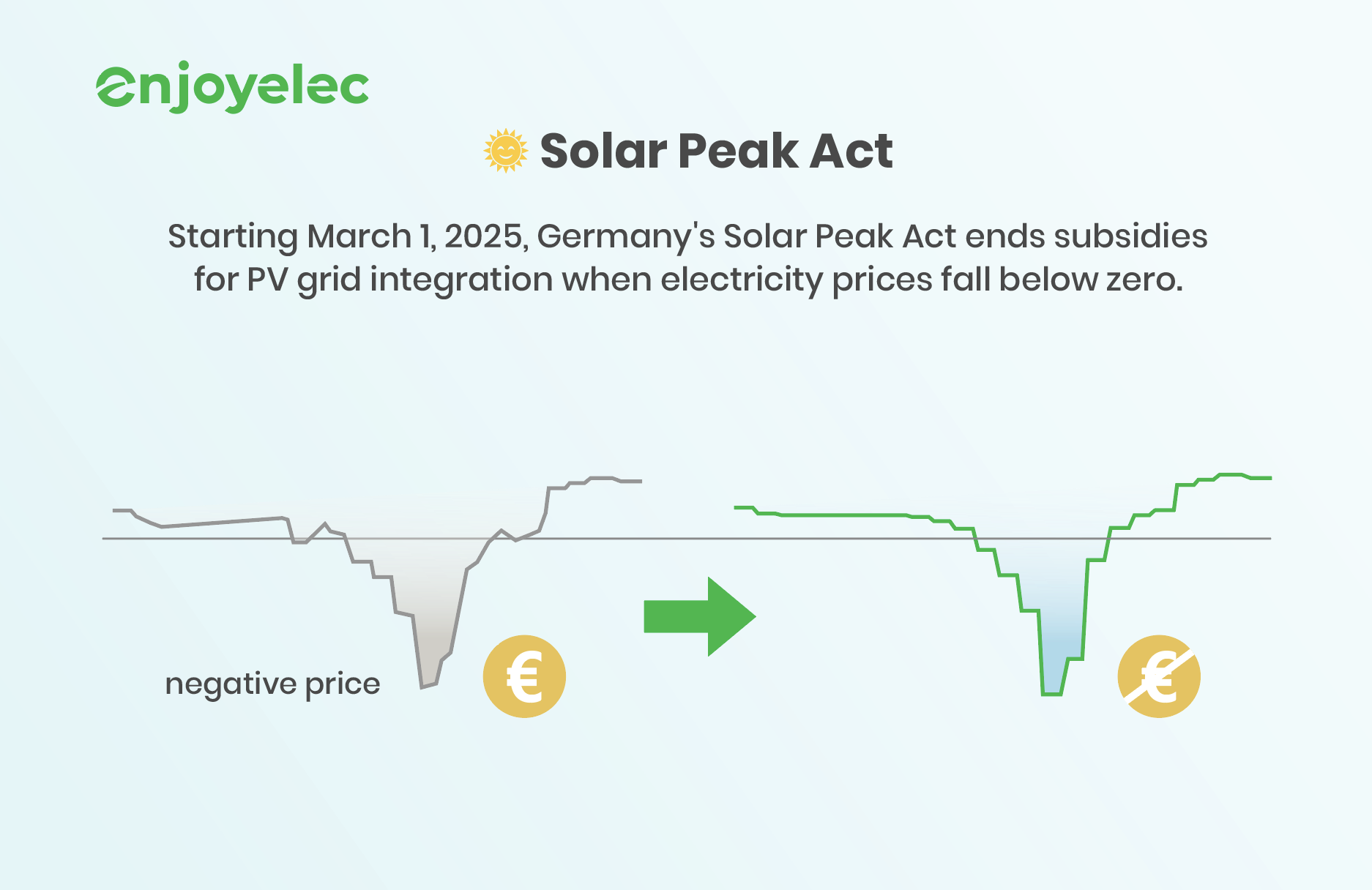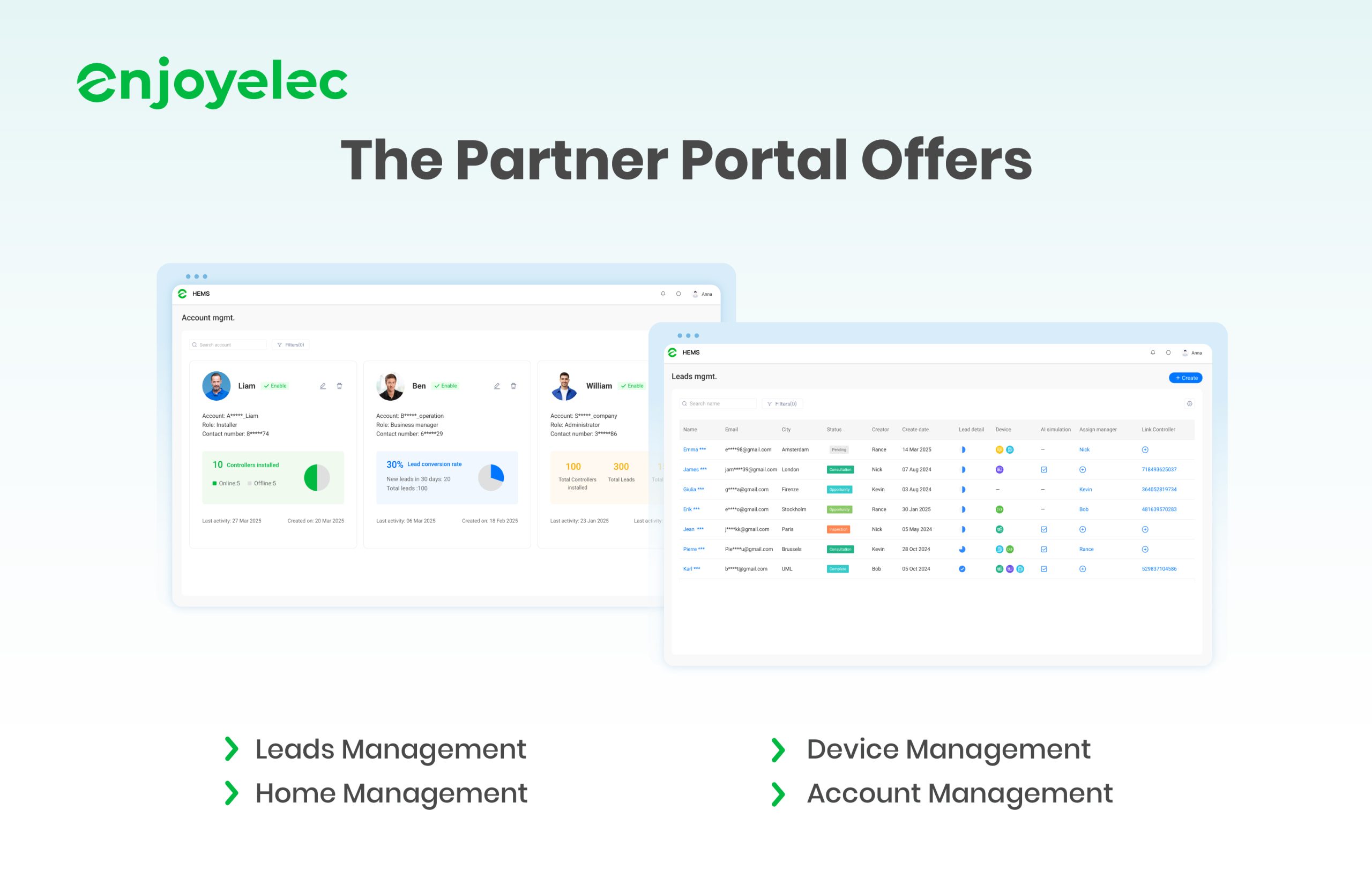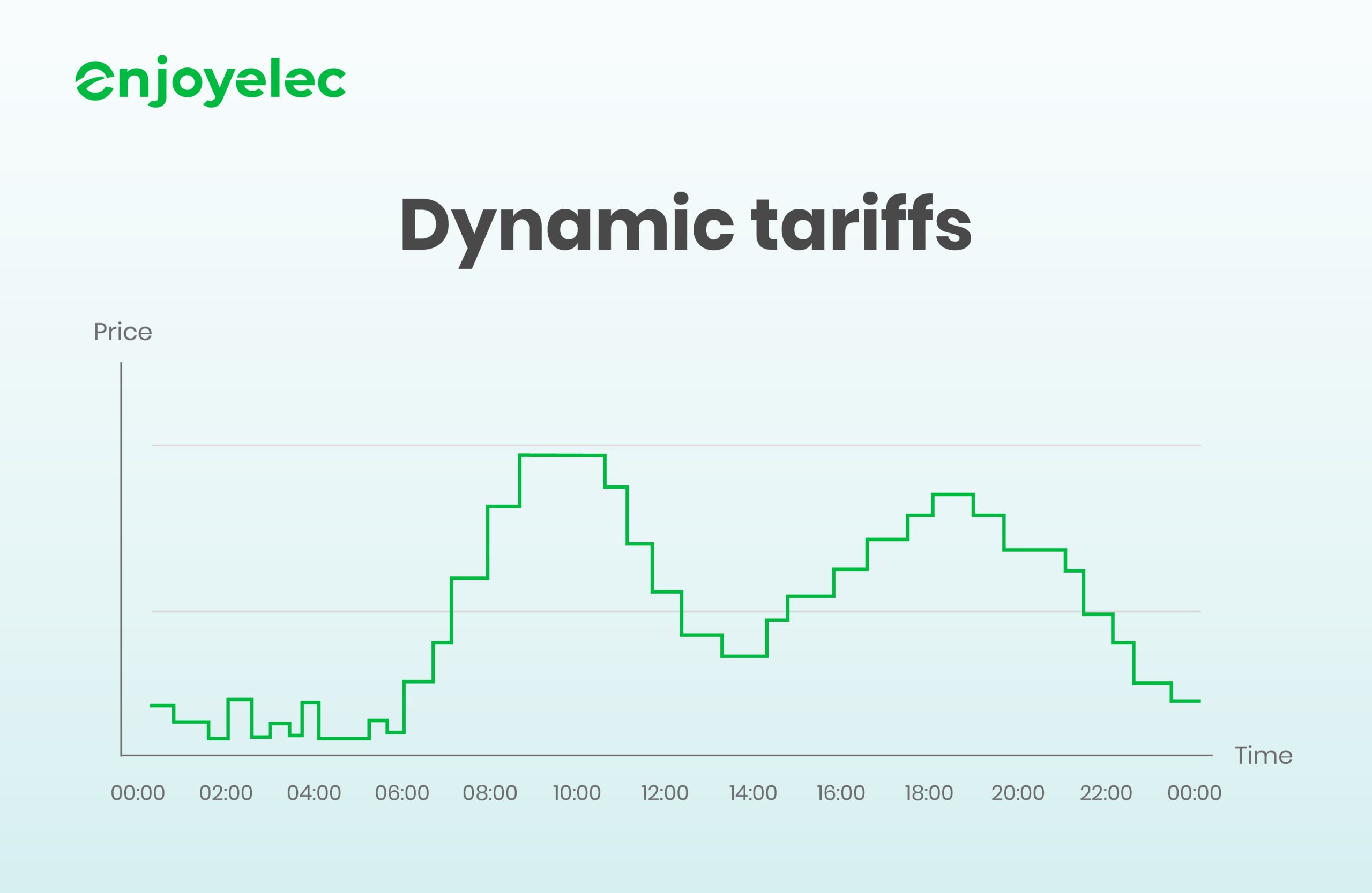Solar Peak Act: Curbing Negative Prices
Solar Peak Act
As Germany continues to expand renewable energy sources like solar and wind, the issue of negative electricity prices in the market has worsened, with negative pricing periods reaching 457 hours in 2024. To address this, the German Parliament recently passed a series of amendments to key laws, including the Energy Industry Act (paragraph 14a EnWG), Metering Point Operation Act (MsbG), and Renewable Energy Act (paragraph 9 EEG), collectively known as the Solar Peak Act. This new legislation removes subsidies for PV systems under 100 kW during of negative price periods. The updated regulation now applies to all PV systems over 2 kW, aiming to alleviate the negative pricing issue and enhance market stability.

Key Policy Reforms
To tackle these challenges, Germany has introduced key reforms aimed at reducing grid strain and ensuring market stability:

- Generation Limitations for New Solar Installations
New solar plants under 100 kWp will be temporarily limited to exporting only 60% of their rated capacity until they install a Control Box, after which the restriction is lifted. Existing systems are unaffected, but owners can voluntarily install a Control Box to receive an additional €0.006/kWh EEG subsidy. This measure prevents excessive solar injection into the grid during peak production hours.
- Mandatory Smart Meters for 7 kW+ Systems
All new PV systems above 7 kW must be equipped with smart meters and control technology for better grid integration and energy optimization. Small-scale plug-in solar systems below 7 kW that do not feed into the grid are exempt.
- Exemptions for Energy Storage Systems
PV systems with home energy storage systems are exempt from generation limits, allowing them to store surplus power instead of injecting it into the grid. This incentivizes self-consumption and flexible energy management.
- Easier Market Access for Small Solar Systems (<100 kW)
Small-scale solar plants under 100 kWp can voluntarily sell electricity directly on the market. The process for market participation is being simplified, removing previous barriers to entry.
- Extend Subsidy Durations for Compensation
The bill extends subsidy periods to support solar operators, helping them recover revenue losses and maintain investments in solar expansion and energy storage.
Why the Law Was Introduced: Solar and Grid Challenges
- The Negative Price Crisis
Germany’s rapid expansion of solar and wind power has led to a surge in negative electricity prices. According to Timera Energy, Germany recorded 457 hours of negative power prices in 2024, a significant increase from previous years.
This issue stems from the intermittent nature of renewable energy. Solar power depends on sunlight, and wind power relies on wind conditions—both of which don’t always align with market demand. During low-demand periods with high solar generation, such as midday on sunny days, an oversupply of electricity pushes prices below zero. This not only results in financial losses for producers but also raises concerns about grid stability and investment confidence in renewable energy.
- The Boom in Solar Installations and Grid Bottlenecks
By the end of 2024, Germany’s total installed solar capacity approached 100 GW, with an additional 16.73 GW added that year alone. However, grid infrastructure upgrades have not kept pace.
During peak solar production hours, excess electricity floods the grid, leading to localized grid congestion and curtailment. In many cases, solar power is wasted because the infrastructure cannot handle the load.
As of January 2025, Germany needs to add 1.61 GW of solar capacity per month to meet its 2030 target of 215 GW. However, without major grid reinforcements, this rapid expansion may exacerbate grid constraints, limiting the full potential of renewable energy.
What Does This Mean for Homeowners?
- Maximize Self-Consumption, Minimize Costs
With the Solar Peak Act 2025, self-consumption is becoming more valuable than ever. Instead of relying on feed-in tariffs and fluctuating electricity prices, homeowners can use their solar power directly —cutting energy costs and reducing dependence on the public grid. Consuming electricity on-site is not only more affordable but also helps stabilize the grid by supporting a decentralized energy supply.
- Smart Meters: A Game Changer
A key update under the Solar Peak Act is the mandatory rollout of smart meters, which make home energy management more efficient and transparent. These digital meters enable automated energy optimization, ensuring homeowners get the most out of their solar power while improving overall energy distribution.
- A Future-Proof Energy Solution
Beyond environmental benefits, self-consumption offers long-term financial advantages. Homeowners can lower their electricity bills with clean, locally generated solar energy, while also increasing their property’s value with future-ready energy solutions. By investing in smart solar consumption, they gain energy independence and actively contribute to a sustainable, low-carbon future.
Maximizing Savings Under the Solar Peak Act: How HEMS and Dynamic Tariffs Mitigate Losses
Scenario 1: Standard PV System
In a traditional standard photovoltaic (PV) system, the annual feed-in tariff drops from €289.28 to €254.16, while the annual electricity bill increases from €386.04 to €421.16. The new policy introduces restrictions such as the inability to receive subsidies during negative price periods and a 60% grid export limit. These factors combine to increase overall costs, placing greater financial pressure on users relying solely on a standard PV system.
Annual cost increase: €35.12
Scenario 2: PV System with Storage
When a storage system is added, self-consumption improves, partially mitigating the effects of the new policy. In this scenario, the annual feed-in tariff decreases from €210.39 to €188.13, and the annual electricity bill increases from €137.56 to €159.82. Although the storage system enhances energy utilization, it still cannot completely offset the policy’s financial implications.
Annual cost increase: €22.25
Scenario 3: PV System with Storage, Dynamic Tariff, and HEMS
In the optimal scenario, integrating a PV system with storage, dynamic tariffs, and HEMS offers transformative financial and operational benefits. By optimizing self-consumption of solar energy, the system minimizes electricity costs and employs an optimal strategy to sell surplus energy back to the grid. The system reduces annual costs to €204.85 with a diminished feed-in tariff of €156.02, resulting in a net annual bill of only €48.83.
Annual savings vs. standard PV system: €372.33
Annual savings vs. PV with storage: €110.99
20-year savings vs. standard PV system: €7446.64
20-year savings vs. PV with storage: €2219.80
Methodology:
- Annual electricity consumption is assumed to be below 6000 kWh, explicitly excluding high-consumption devices such as electric vehicles and heat pumps.
- The configuration with a total installed PV capacity of approximately 10 kWp was selected.
- Select users with an average annual PV generation of 4550 kWh.
- New PV system electricity price: €30.75 c/kWh
- Traditional grid electricity purchase price: €35 c/kWh
- New PV system feed-in tariff: €7.94 c/kWh
- Traditional PV system feed-in tariff: €8.03 c/kWh
- Our system optimizes self-consumption by exporting at peak prices, using energy locally at off-peak hours, and prioritizing battery charging or household loads during negative pricing.
Your opportunities with enjoyelec HEMS:

- Optimized Self-Consumption
Our HEMS intelligently manages PV, battery storage, heat pumps, and EV chargers to maximize self-sufficiency. By analyzing energy demand, grid conditions, and tariffs, it optimally allocates resources to ensure higher self-consumption and lower energy costs. With dynamic tariff integration, it strategically shifts energy usage to off-peak hours, further reducing expenses and enhancing sustainability. - Anti-Backflow Control
To prevent unnecessary energy losses, our HEMS features an advanced anti-backflow mechanism that dynamically maximizes battery charging when electricity prices turn negative. This prevents excess energy from being exported, helping users avoid paragraph 14a penalties while maintaining grid stability and ensuring efficient energy utilization. - Flexible Protocol Integration
Our HEMS supports seamless integration with various communication protocols, allowing it to dynamically adjust energy consumption in response to real-time conditions. By intelligently managing controllable loads such as heat pumps and EV chargers, it ensures optimal solar energy utilization while balancing supply and demand efficiently. - Grid-Friendly Flexibility
Our AI-powered HEMS adapts energy consumption based on real-time pricing signals. It prioritizes charging during low-price or off-peak periods, reducing costs for homeowners while contributing to grid stability. By aligning household energy usage with available renewable energy supply, it enhances both economic and environmental benefits.
Future Outlook: Navigating Germany’s Renewable Energy Transition
- Rapid Growth of Energy Storage Systems
Energy storage systems are becoming a critical pillar for grid stability. Advanced battery solutions provide temporary grid energy storage and peak shaving services, essential for balancing the variable output of solar and wind power. New policies are set to allow home energy storage systems to directly participate in electricity market transactions, broadening profit opportunities while easing grid congestion. This strategic move not only supports a resilient, flexible power system but also drives significant growth within the energy storage industry.
- Advancements in Home Energy Management Systems (HEMS)
HEMS are transforming the way consumers interact with energy markets. As renewable generation remains inherently variable, HEMS offer enhanced flexibility by providing real-time energy monitoring, automated demand response, and dynamic consumption optimization. These smart systems empower homeowners to adjust energy use based on real-time conditions and dynamic tariffs, ensuring that both individual households and the broader grid can adapt quickly to fluctuations in supply and demand.
- Enhanced Flexibility and Responsiveness of the Electricity Market
The evolving dynamics of the electricity market will demand greater flexibility and faster response times. As renewable energy generation remains inherently variable, market mechanisms will need to adapt quickly—spurring further innovations and reforms. This increased agility is essential to balance supply and demand effectively in a grid powered predominantly by renewables.
- Policy and technical support
The government’s goal is to achieve 80% renewable energy supply by 2030, which places higher demands on grid balancing. Energy storage systems have become an important pillar for achieving this goal.
New policies are undoubtedly a growth opportunity for the energy storage industry, but they also mean that market barriers will increase significantly and need to be dealt with carefully. It is reported that the German Bundestag is planning to pass a new bill that will allow home energy storage systems to directly participate in electricity market transactions and provide system services such as temporary grid energy storage and peak shaving. This undoubtedly broadens the profit path for energy storage systems and alleviates peak grid loads, which is a win-win situation.
Ready to maximize your solar investments? With enjoyelec’s advanced HEMS, you can seamlessly integrate solar energy, optimize storage, and enhance grid interaction—all while staying compliant with evolving regulations.
Take the first step toward a smarter, more efficient energy future today.


Connect with us at http://www.linkedin.com/company/enjoyelec for the latest updates, insights, and news. We look forward to engaging with you and sharing our journey towards a smarter energy future.





